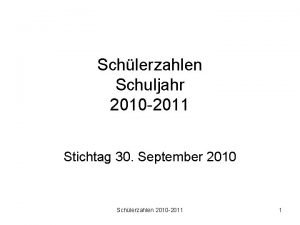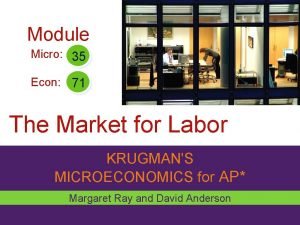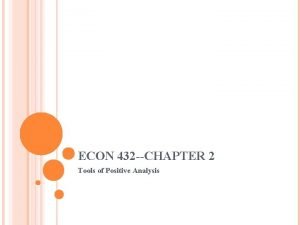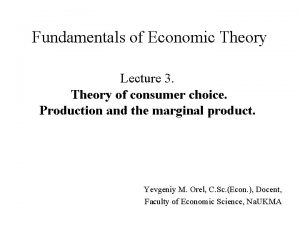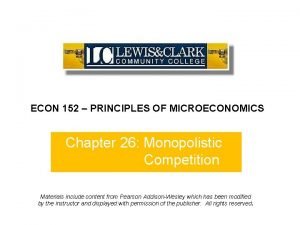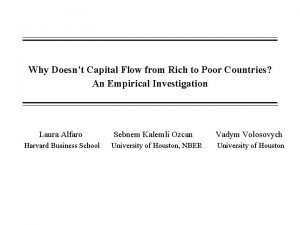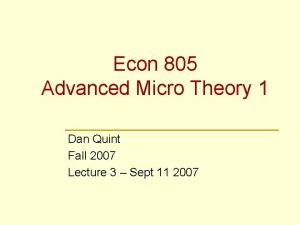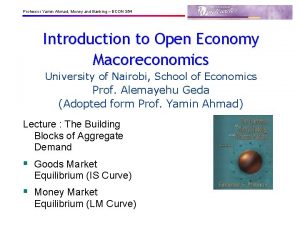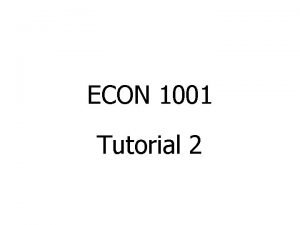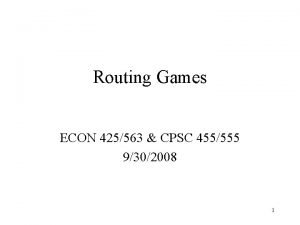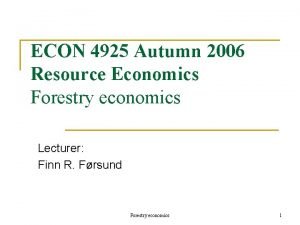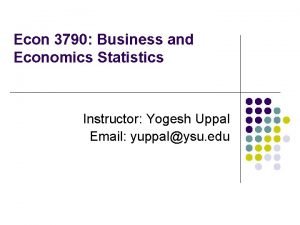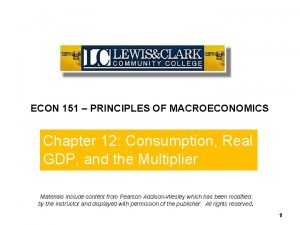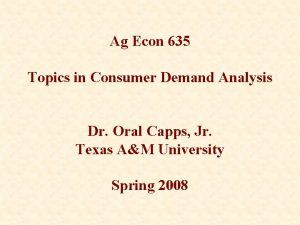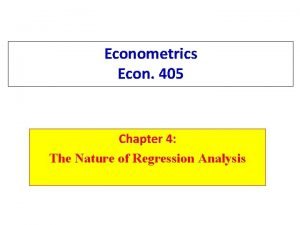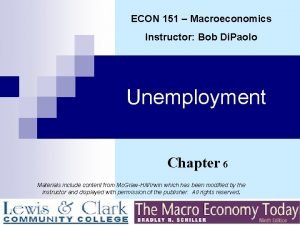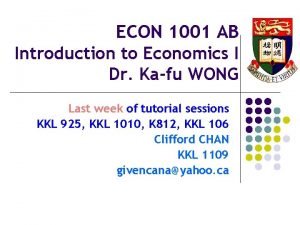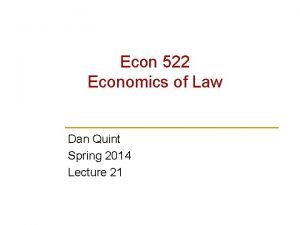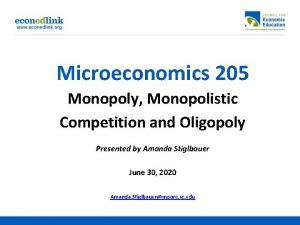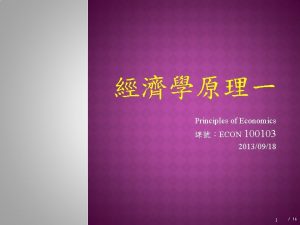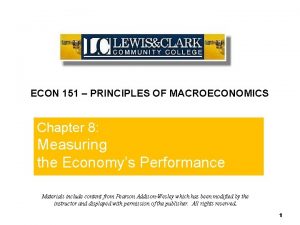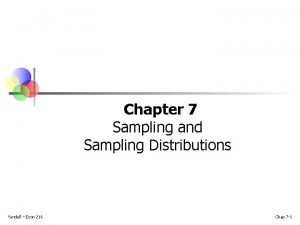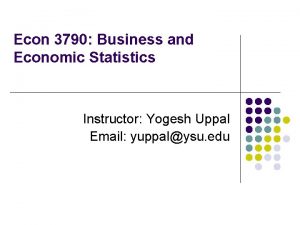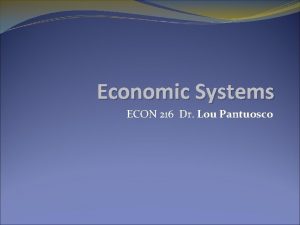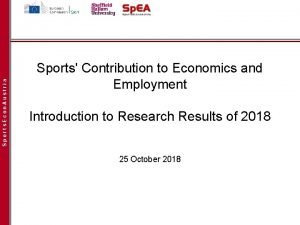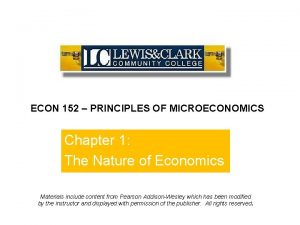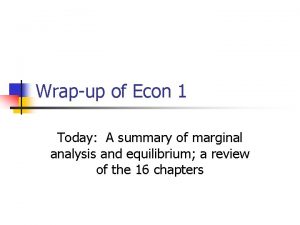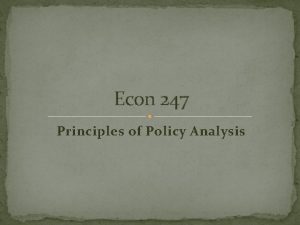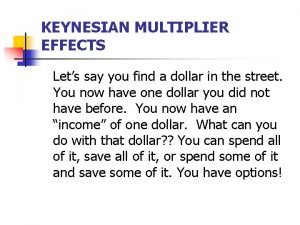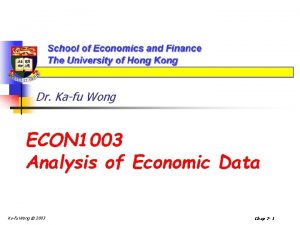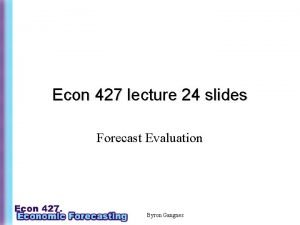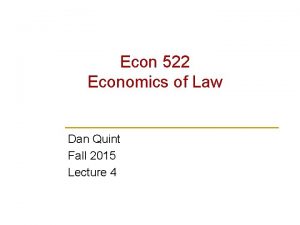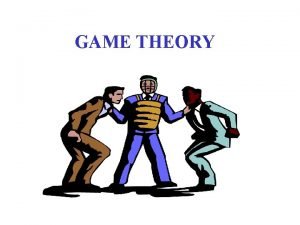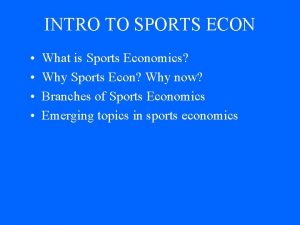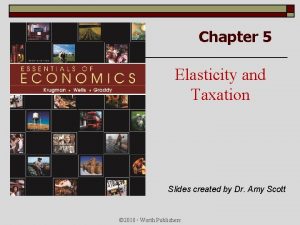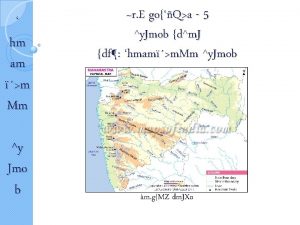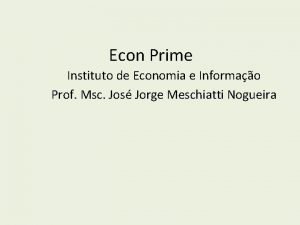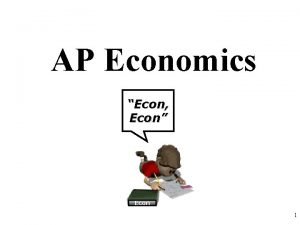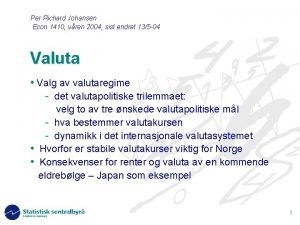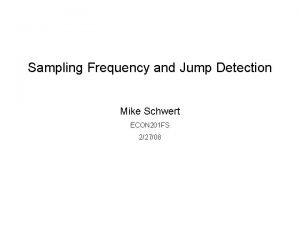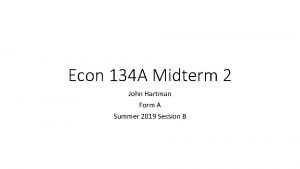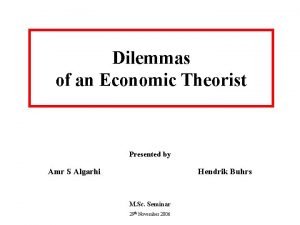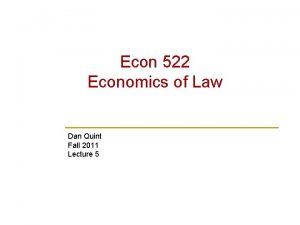Micro Mc Eachern ECON 9 Micro 2010 2011































































- Slides: 63

Micro Mc. Eachern ECON 9 Micro 2010 -2011 CHAPTER Designed by Amy Mc. Guire, B-books, Ltd. Monopoly

Monopoly Pure Monopoly - a single firm that produces all the output in a particular market with no close substitutes and high barriers to entry.

Barriers to Entry § § Monopoly – Sole supplier of a product with no close substitutes Barriers to entry 1. Legal restrictions 2. Economies of scale 3. Control of essential resources LO 1

Barriers to Entry 1. Legal restrictions – Patents and invention incentives • Patent – exclusive right for 20 years – Licenses and other entry restrictions • Federal license • State license LO 1

Barriers to Entry 2. Economies of scale – Natural monopoly – Downward-sloping LRAC curve • One firm can supply market demand at a lower ATC per unit than could two firms LO 1

LO 1 Exhibit 1 Economies of Scale as a Barrier to Entry Cost per unit $ A monopoly sometimes emerges naturally when a firm experiences economies of scale as reflected by a downward-sloping long-run average cost curve. Long-run average cost Quantity period One firm can satisfy market demand at a lower average cost per unit than could two or more firms, each operating at smaller rates of output.

Case Study LO 1 Is a Diamond Forever? u 1866, De. Beers u Great Depression – lower diamond prices u De. Beers: control the world supply of uncut diamonds u To increase consumer demand u Marketing “A diamond is forever” u Lasts forever, so should love u Remain in the family u Retain their value

Case Study LO 1 Is a Diamond Forever? u Limit the supply of rough diamonds u Buyers: wholesalers u Box of uncut diamonds at a set price u No negotiations u Violates U. S. antitrust laws u Mid 1990 s: lose control of some rough diamond supplies u Russia u Australia (Argyle) u Canada (Yellowknife)

Monopoly § Monopoly – Local – National – International § Long-lasting monopolies – Rare – Economic profit attracts competitors LO 2

Monopoly in the Short-Run What makes monopoly different from pure competition is the firm’s demand curve. Since the firm is the market, the firm’s demand curve is the market demand curve Hence, it’s downward sloping

Monopoly in the Short Run A profit-maximizing monopolist, then not only chooses how much to produce, but also chooses what price to charge. What prevents a monopolist from charging an amazingly high price? there may not be much demand at that price So a monopolist wants to get the highest price that maximizes their profit

Monopoly and Total Revenue Profits = Total Revenue - Total Cost But Total Revenue is different for a monopolist than in pure competition In pure competition the more you sell, the more the total revenue, For Monopoly if you sell more you have to lower your price. Remember when we discussed elasticity, we looked at how total revenue changes as you move down a demand curve

Monopoly and Total Revenue Elastic $ Elasticity = 1 Inelastic Demand Q $ Total Revenue Q

Monopoly Profit So does a monopolist want to produce at the quantity where elasticity equals 1 and total revenue is at a maximum? Not necessarily. Remember we need to consider total cost, as well The monopolist wants to maximize the difference between total revenue and total cost

Monopoly Profit Maximization Like pure competition, this is the quantity where the slopes of the TC and TR curves are the same And also like pure competition, this is the quantity where MR = MC. But the MR curve looks different, since the demand curve is downward sloping

Total Revenue and Total Cost TC $ Slope of TR = Slope of TC MR = MC TR Q* Q

Price & Marginal Revenue Under Monopoly P $142 132 As price decreases from $142 to $132. . . but revenue will increase with the additional units sold Loss = $30 D Gain = $132 MR = $102 1 2 3 4 5 6 Q

Monopoly Revenue and Cost Quantity Price of (Average Total Marginal Output Revenue) Revenue 0 1 2 3 4 5 6 7 8 9 10 $172 162 152 142 132 122 112 102 92 82 72 $ 0 ] 162 ] 304 ] 426 ] 528 ] 610 ] 672 ] 714 ] 736 ] 738 ] 720 Average Total Cost $162 $190. 00 142 135. 00 122 113. 33 102 100. 00 82 94. 00 62 91. 67 42 91. 43 22 93. 73 2 97. 78 - 18 103. 00 Total Cost $100 190 270 340 400 470 550 640 750 880 1030 Marginal Cost ] 90 ] 80 ] 70 ] 60 ] 70 ] 80 ] 90 ] 110 ] 130 ] 150 Profit + or loss - - $100 - 28 + 34 + 86 + 128 + 140 + 122 + 74 - 142 - 310

Monopoly Revenue and Cost Quantity Price of (Average Total Marginal Output Revenue) Revenue 0 1 2 3 4 5 6 7 8 9 10 $172 162 152 142 132 122 112 102 92 82 72 $ 0 ] 162 ] 304 ] 426 ] 528 ] 610 ] 672 ] 714 ] 736 ] 738 ] 720 Average Total Cost $162 $190. 00 142 135. 00 122 113. 33 102 100. 00 82 94. 00 62 91. 67 42 91. 43 22 93. 73 2 97. 78 - 18 103. 00 Total Cost $100 190 270 340 400 470 550 640 750 880 1030 Marginal Cost ] 90 ] 80 ] 70 ] 60 ] 70 ] 80 ] 90 ] 110 ] 130 ] 150 Profit + or loss - - $100 - 28 + 34 + 86 + 128 + 140 + 122 + 74 - 142 - 310

A simple example - D and MR

D, TR, and MR

D and MR P $10 8 6 Notice that MR < P 4 2 0 1 2 MR 3 4 D 5 Q

Profit Maximizing P MC $10 8 6 4 2 0 1 2 MR 3 4 D 5 Q

Profit Maximizing So the monopolist chooses the quantity where MC=MR (a quantity of 2, in this example) If they chose less, MR>MC so they could get more money from selling one more than it would cost to make one more unit. They choose the highest price they can charge in order to sell Q*

Profit Maximizing P MC $10 8 6 4 2 0 1 2 MR 3 4 D 5 Q

Profit Maximizing The price is found by looking to the demand curve and finding the price people are will to pay in order to buy the quantity the firm wants to produce In the case of this example, this is a price of $6. How do we show the profit in this case?

Profit Maximizing P MC $10 ATC 8 6 atc* 4 2 0 MR 1 2 D 3 4 5 Q

Profit Maximizing P MC $10 8 6 atc* 4 ATC Profit 2 0 MR 1 2 D 3 4 5 Q

MR = MC Slope of TR = Slope of TC MR = MC

Shut Down Rules A monopolist faces the same short run shut down rules as a pure competitive firm for all of the same reasons As long as P>AVC, the firm is paying off some fixed cost and should stay open in the short run If P<AVC, the firm should shut down. Just because the firm is a monopolist, does not guarantee a profit.

A Monopolist Who is making a loss but should not Shut Down ATC P MC $10 atc* 8 6 avc* AVC P > AVC avc* 4 2 0 1 2 MR 3 4 D 5 Q

A Monopolist Who is making a loss but should not Shut Down ATC P MC $10 atc* 8 6 AVC Loss P > AVC avc* 4 2 0 1 2 MR 3 4 D 5 Q

A Monopolist Who Should Shut Down ATC AVC P MC $10 atc* 8 6 avc* Loss P < AVC 4 2 0 1 2 MR 3 4 D 5 Q

A Monopolist Who Should Shut Down ATC AVC P MC $10 atc* TFC 8 avc* Loss 6 P < AVC 4 2 D 0 1 2 MR 3 4 5 Q

Profit Maximizing Q* - where MR = MC (profit maximization) P* - highest P consumers are willing and able to pay for Q* Demand curve at Q* In the Short-Run a Monopolist may Make Profits Break Even Operate at a Loss

LO 3 Short-Run Losses; Shutdown Decision § If p>ATC § Economic profit § If ATC>p>AVC § Economic loss § Produce in short run § If p<AVC: AVC curve above D curve § Economic loss § Shut down in short run $

LO 3 Exhibit 7 The Monopolist Minimizes Losses in the Short Run Marginal cost a Dollars per unit p 0 Loss b Average total cost MR=MC at point e: quantity Q Demand=Average revenue Marginal revenue Q P<ATC, monopolist suffers a loss For Q, price=p at point b, Average variable cost on D curve c e For Q, ATC is at point a Quantity period Monopolist continue to produce because p>AVC (AVC is at point c)

Profit Maximizing P MC $10 ATC 8 6 atc* Profit 4 2 0 MR 1 2 D 3 4 5 Q

Profit and Cost Areas TVC = 0 QFC TR = 0 QEB TC = 0 QDA Loss = BEDA

Monopoly in the Long-Run If Losses in Short-Run seem persistent Firm exits the Industry Disappears The last Movie Theatre closes If Profits or Break-Even in the Short-Run Profit may or may not persist in the long run

Why Monopoly Profits Persist Since there are barriers to entry, firms don’t enter the industry and drive down prices

Benefits of Monopoly Technological Innovations Incentive for monopoly profits gives firm an incentive to innovate.

Monopoly and Allocation of Resources § Monopoly – Marginal benefit MB = p > MC – MB not = MC – Restrict Q below what would maximize social welfare – Economic profit – Deadweight loss of monopoly • Allocative inefficiency LO 4

Disadvantages of Monopoly: Inefficient Allocation of Resources Allocatively Inefficient (P > MC) If the price is greater than MC consumers will stop buying the product before MB = MC So they will stop where MB = P > MC Productively Inefficient (P not = min ATC)

Productive Inefficient P MC $10 8 atc* 6 4 ATC 2 0 MR 1 2 D 3 4 5 Q

Comparison of Monopoly and Pure Competition We can compare Monopoly and Pure Competition by looking at the misallocation of resources which result from the P > MC situation.

Monopoly vs Pure Comp. P MC = Spure comp. MB = P = MC P P Monopoly Pure Comp. produces Where P = MC Pure comp MR 0 Q Monopoly Q pure comp D Q

Monopoly vs Pure Comp. P P P MC = Spure comp. The area of this triangle is the dead weight loss. Units should be produced Where MB > MC Monopoly pure comp MR 0 Q M Q pure comp D Q

Economic Effects of Monopoly Price, Output, and Efficiency Pure Monopoly Purely Competitive Market S = MC MC b Pm MB = P = MC Minimum ATC Pc c Pc a D Qc MR Qm Qc Pure Competition is Efficient Monopoly Price is Greater Than MC And Is Therefore Inefficient D

Price Discrimination § Charge different prices to different groups of consumers, when there is no difference in the cost of serving them. § Conditions – Downward sloping D curve – At last two groups of consumers • Different price elasticity of demand – Ability to charge different prices • At low cost – Prevent reselling of the product LO 6

Price Discrimination Two Forms: 1. Charging Some Customers One Price and a Different Price for Other Customers – usually based on elasticity of demand 2. Charging Each Customer the Maximum They Are Willing to Pay – a different price to every customer

Price Discriminating Monopolist P MC $10 Inelastic Customer Group - Charged Higher Price 8 6 4 2 0 MR 1 2 D 3 4 5 Q

Price Discriminating Monopolist P MC $10 8 Elastic Customer Group - Charge Lower Price 6 4 2 0 1 MR 2 3 D 4 5 Q

Examples of Price Discriminating Behavior Coupons Airline Tickets Dry Cleaning and Haircuts (? ) (…think gender) Kids Meals at restaurants (think family budget here) Matinee showings of movies The idea is that the monopolist charges a higher price to the consumer group with more inelastic demand

Perfect Price Discrimination A Perfectly Price Discriminating Monopolist is a monopolist who charges everyone exactly what they are willing to pay In other words, they work their way down the demand curve, lowering the price only to those who aren’t willing to pay the high price, until P=MC Example - Auctions

Perfect Price Discriminating Monopolist P MC $10 8 Each Customer pays a different price For the last purchase P = MR = MC 6 4 2 0 D 1 2 3 4 5 Q

Perfect Price Discrimination Note that in this case there is no dead weight loss AND the firm is allocatively efficient, but the monopolist captures all the consumer surplus.

Natural of Monopoly Natural Monopoly - a monopolist whose LRAC decreases over the relevant range of output. Economies of Scale - monopolist can produce at lower costs.

Natural Monopoly P At this quantity only one firm can produce LRAC SRAC D Q Q

Natural Monopoly While Costs are lower, price can still be relatively "high" since P > MC in monopoly. Sometimes, Government regulates natural monopolies to lower price. Ex: Public Utilities A Natural Monopoly is an industry where is can be more efficient to let one firm provide the good (because of economies of scale).

Regulated Monopoly Natural Monopolies Rate Regulation Socially Optimum Price P = MC Fair Return Price P = ATC

Regulated Monopoly Dilemma of Regulation Price and Costs (Dollars) Can we regulate a firm to make an Economic Loss? Monopoly Price Fair-Return Price Pm f Pf a Socially Optimal Price P < ATC Pr r MR 0 Qm MC D b Qf Quantity Qr

pure monopoly barriers to entry Profit Maximizing Behavior Shut-down rules price discrimination socially optimal price MC = P Producers Surplus Dead weight loss Allocation efficiency MC = P = MB dilemma of regulation
 Schuljahr 2010/2011
Schuljahr 2010/2011 2010 micro frq
2010 micro frq Econ muni
Econ muni What is a positive analysis
What is a positive analysis Econ
Econ Mpc ap econ
Mpc ap econ Econ 152
Econ 152 Gertler econ
Gertler econ Ivrents
Ivrents Yogesh uppal
Yogesh uppal Econ
Econ Econ 424
Econ 424 Yamin ahmad
Yamin ahmad Econ
Econ Flipit econ
Flipit econ Econ 105
Econ 105 Econ
Econ Econ
Econ Econ
Econ Econ
Econ Gdp formula
Gdp formula Marginal analysis in economics
Marginal analysis in economics Roy's identity
Roy's identity Econ 206
Econ 206 Econ 405
Econ 405 Econ 151
Econ 151 Velocity formula econ
Velocity formula econ Econ
Econ Econ
Econ Mr darp econ
Mr darp econ Monopoly market graph
Monopoly market graph Nthu econ
Nthu econ Econ 151
Econ 151 Econ chapter 7
Econ chapter 7 Gertler econ
Gertler econ Econ
Econ Econ
Econ Sports econ austria
Sports econ austria Www.econ.muni.cz
Www.econ.muni.cz Econ 152
Econ 152 Econ
Econ Econ 247
Econ 247 Mpc econ formula
Mpc econ formula Econ 134
Econ 134 Kafu wong
Kafu wong Econ
Econ Econ
Econ Game theory econ
Game theory econ Econ ra twitter
Econ ra twitter Sports economics definition
Sports economics definition Midpoint method formula
Midpoint method formula Esf muni harmonogram
Esf muni harmonogram Hm a m
Hm a m Econ
Econ Prime econ
Prime econ Econ
Econ Econ 1410
Econ 1410 Econ
Econ Econ
Econ Fiscal policy ib
Fiscal policy ib Econ 134
Econ 134 Econ 134
Econ 134 Econ
Econ Econ
Econ
